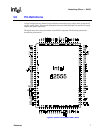
Datasheet 13
Networking Silicon — 82555
4.0 100BASE-TX Adapter Mode Operation
4.1 100BASE-TX Transmit Clock Generation
A 25 MHz crystal or a 25 MHz oscillator is used to drive the 82555’s X1 and X2 pins. The 82555
derives its internal transmit digital clocks from this crystal or oscillator input. The Transmit Clock
signal is a derivative of the 25 MHz internal clock. The accuracy of the external crystal or oscillator
must be ± 0.0005% (50 PPM).
4.2 100BASE-TX Transmit Blocks
The transmit subsection of the 82555 accepts nibble-wide data on the TXD[3:0] lines when TXEN
is asserted (high). The transmit subsection passes data unconditionally to the 4B/5B encoder as
long as TXEN is active.
The 4B/5B encoder accepts nibble-wide data (4 bits) from the MAC and compiles it into 5-bit-wide
parallel symbols. These symbols are scrambled and serialized into a 125 Mbps bit stream,
converted by the analog transmit driver into a MLT-3 waveform format, and transmitted onto the
Unshielded Twisted Pair (UTP) or Shielded Twisted Pair (STP) wire.
4.2.1 100BASE-TX 4B/5B Encoder
The 4B/5B encoder complies with the IEEE 802.3u 100BASE-TX standard. Four bits are encoded
according to the transmit 4B/5B lookup table. The lookup table matches a 5-bit code to each 4-bit
code.
The table below illustrates the 4B/5B encoding scheme associated with the given symbol.
Table 2. 4B/5B Encoder
Symbol 5B Symbol Code 4B Nibble Code
0 11110 0000
1 01001 0001
2 10100 0010
3 10101 0011
4 01010 0100
5 01011 0101
6 01110 0110
7 01111 0111
8 10010 1000
9 10011 1001
A 10110 1010
B 10111 1011
C 11010 1100
D 11011 1101


















